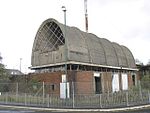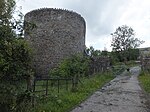The Brynmawr rubber factory is a now-demolished building which was situated in Brynmawr in Blaenau Gwent, Wales. It was designed and constructed between 1946 and 1952 by the Architects' Co-Partnership, a group of architecture alumni from the Architectural Association in London, in collaboration with engineer Ove Arup. Featuring a nine-domed concrete ceiling, the building was part of the "Festival of Britain period" in architecture and became the first post-war building to receive listed status, with a Grade-II* designation in 1986. Despite this status, the building was demolished in 2001 leaving only the boiler house intact, and the site is now occupied by housing and a superstore.
The building was commissioned by the industrialist Lord James Forrester for Enfield Cables, of which he was a director. Forrester had been part of the pre-war Brynmawr Experiment, which aimed to revive the town following the Great Depression. His desire for regeneration led to his decision to situate the factory in Brynmawr, despite it not being the best location commercially. Enfield Cables were not able to make the site economically viable after opening, and it was taken over by the Dunlop Rubber Company, operating under the brand name Dunlop Semtex. Dunlop Semtex achieved success with the factory, producing flooring for the health and education sectors, going on to buy the site in 1964. A downturn in fortunes in the late 1970s and early 1980s led to the factory's closure in 1981.







